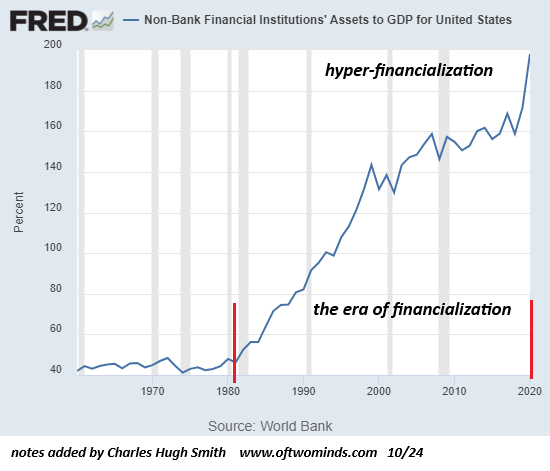Collapse Is the Only Reform
This post Collapse Is the Only Reform appeared first on Daily Reckoning.
Thanks to recency bias, we tend to think the world has always been more or less as it is today. Tectonic shifts beneath the veneer of everyday life escape us unless we make a concerted effort to peel back the veneer of normalcy.
For example, consider the rise of finance as the dominant force in our socioeconomic/political status quo. Statista gives us a rough picture of the dominance:
In 2023, the finance, insurance, real estate, rental, and leasing industry contributed 20.7% to the United States’ gross domestic product (GDP). This is higher than the long-term average of 7.29%. In 1947, the finance industry made up only 10% of non-farm business profits. By 2010, the finance industry made up 50% of non-farm business profits.
The chart below of non-bank financial institutions’ assets as a percentage of GDP tells the story: prior to the era of financialization, non-bank financial institutions’ assets trundled along for decades at around 40% of GDP.
Recall that “non-bank financial institutions” is shorthand for the mechanisms of financialization, which is the globalized commoditization of everything into a tradable financial instrument.
Labor, capital, risk, currencies, commodities, income streams, real-world assets — everything is converted into a financial doppelganger that can be arbitraged and traded for profit. The actual use-value is no longer the “value” being “created”; the “value” is “created” by generating an entirely abstract financial shadow cast by the collateral of the real world.
Way out of Whack
This transmogrification of the global economy into a fully financialized shadow world took off in the early 1980s when financiers were first given access to unlimited credit and the other tools of financialization.
Non-bank financial institutions’ assets soon soared from 40% of GDP to 140% of GDP, and in the final blow-off phase of hyperfinancialization that we’re experiencing now, these assets are 200% of GDP — five times the pre-financialization era levels that were deemed “widespread prosperity” (the Trente Glorieuses, the 30 glorious years of shared prosperity from 1945–1975).
The wealth generated by financialization and hyper-financialization isn’t shared; it’s concentrated in the hands of those with access to credit and the other tools of financialization, currently epitomized by private equity.
This excerpt from a post on promarket.org illuminates the reality that financialization isn’t cost-free to the economy:
Epstein and Montecino argue that the total cost of the financial system is comprised of rents, misallocation costs and the costs of the 2008 crisis. Such costs can be divided into two types: transfers and inefficiencies. When combined together, Epstein and Montecino estimate that they total to $688 billion a year, or 4% of GDP. Cumulatively, from 1990–2023, this number would add up to $22.7 trillion.
Adjusted for inflation, this sum totals $30.2 trillion in today’s dollars — larger than America’s entire GDP of $27 trillion.
An Inherently Unstable System
The larger point is that an economy that’s dependent on the distortions of financialization for its “growth” and profits is not a stable system. The gross imbalances generated by the distortions undermine its stability, and the system collapses under its own weight once the imbalances destabilize society and the real-world economy.
As historian Peter Turchin has documented, the cycle of socioeconomic-political disintegration-integration runs around 50 years, and so here we are. Turchin caught some flak for predicting the handbasket would start its slide into heck in 2020, and voila.
Having lived through the last cycle of tumult, discord and disintegration, that we’re in another such cycle is obvious to me, but not to others. That the end of the Debt-Speculation Super-Cycle is upon us is obvious to many of us, but hotly denied by the multitudes counting on The Everything Bubble never popping.
I had an interesting conversation with a very successful millennial entrepreneur (A.C.) on the question how do we reduce the destabilizing excesses of financialization without crashing the economy?
A.C.’s concern was the immense suffering that would result once the speculative bid of financialization collapsed, something he felt was inevitable if even the most modest restrictions were put in place, for example, restoring the Glass-Steagall separation of commercial from investment banking.
The Moral Universe
That the suffering caused by the implosion of the Everything Bubble will reach every level of society is self-evident and should concern us all. But we must also place all finance-economic questions in the context that we inhabit a moral universe, not a purely mechanical or digital system like a clock or a computer.

In the moral universe, the question is what is the right thing to do now for future generations? The self-evident answer is to deflate the financialization bubble, defang its predatory tools and take the lumps now rather than dump the ever-expanding destructive consequences on the next generation. This can be viewed as our civic/moral duty.
We also discussed an alternative strategy: Wait for the inevitable collapse of the bubble and then clean the nation’s financial house of both the wreckage and the causes of the catastrophe, financialization.
Either way, the implosion of the Everything Bubble will occur and the suffering will be great. We can try to deflate the bubble slowly via restoring Glass-Steagall, etc., but given the extremes of speculative excess, even modest reforms might trigger the collapse.
Take the Pain Now — or Take More Pain Later
Or we can let the bubble implode under its own weight and have a plan ready to clean house when the dust settles. This is the result of letting greed, corruption and fraud run amok for decades under the phony guise of “creating value:”
Once the bill comes due, those responsible will wring their hands, blubbering that they were simply “doing God’s work.” Yes, well, you can tell the preacher on Devil’s Island, where you’ll be living out your retirement.
Can we rein in the excesses of financialization without crashing the economy? Sadly, no. Now that the economy is dependent on the speculative excesses and distortions of financialization, there is no way to avoid the banquet of consequences that has already been served and is only awaiting the seating order.
But we can do what’s right and take the pain now rather than let it pile even higher before it implodes on the next generation’s watch.
Like what you’ve read? Go here for more.
The post Collapse Is the Only Reform appeared first on Daily Reckoning.
This story originally appeared in the Daily Reckoning
Source: https://dailyreckoning.com/collapse-is-the-only-reform/
Anyone can join.
Anyone can contribute.
Anyone can become informed about their world.
"United We Stand" Click Here To Create Your Personal Citizen Journalist Account Today, Be Sure To Invite Your Friends.
Before It’s News® is a community of individuals who report on what’s going on around them, from all around the world. Anyone can join. Anyone can contribute. Anyone can become informed about their world. "United We Stand" Click Here To Create Your Personal Citizen Journalist Account Today, Be Sure To Invite Your Friends.
LION'S MANE PRODUCT
Try Our Lion’s Mane WHOLE MIND Nootropic Blend 60 Capsules
Mushrooms are having a moment. One fabulous fungus in particular, lion’s mane, may help improve memory, depression and anxiety symptoms. They are also an excellent source of nutrients that show promise as a therapy for dementia, and other neurodegenerative diseases. If you’re living with anxiety or depression, you may be curious about all the therapy options out there — including the natural ones.Our Lion’s Mane WHOLE MIND Nootropic Blend has been formulated to utilize the potency of Lion’s mane but also include the benefits of four other Highly Beneficial Mushrooms. Synergistically, they work together to Build your health through improving cognitive function and immunity regardless of your age. Our Nootropic not only improves your Cognitive Function and Activates your Immune System, but it benefits growth of Essential Gut Flora, further enhancing your Vitality.
Our Formula includes: Lion’s Mane Mushrooms which Increase Brain Power through nerve growth, lessen anxiety, reduce depression, and improve concentration. Its an excellent adaptogen, promotes sleep and improves immunity. Shiitake Mushrooms which Fight cancer cells and infectious disease, boost the immune system, promotes brain function, and serves as a source of B vitamins. Maitake Mushrooms which regulate blood sugar levels of diabetics, reduce hypertension and boosts the immune system. Reishi Mushrooms which Fight inflammation, liver disease, fatigue, tumor growth and cancer. They Improve skin disorders and soothes digestive problems, stomach ulcers and leaky gut syndrome. Chaga Mushrooms which have anti-aging effects, boost immune function, improve stamina and athletic performance, even act as a natural aphrodisiac, fighting diabetes and improving liver function. Try Our Lion’s Mane WHOLE MIND Nootropic Blend 60 Capsules Today. Be 100% Satisfied or Receive a Full Money Back Guarantee. Order Yours Today by Following This Link.






